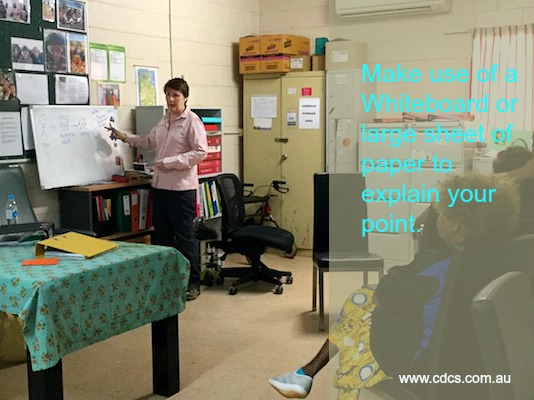According to a recent report by ‘TNS Social Research’, many organisations, particularly those operating in rural and remote locations, as well as those supporting CALD consumers, struggle to have ‘The Conversation’.
You know, the one where you have to talk about the money.
Now I understand your concerns; talking about the dollars can side-track some individuals and/or their family, especially if they think that the package funds can be paid out to them. However, rather than throw the issue into the ‘too hard’ basket, and only making a superficial attempt at Consumer Directed Care, let’s look at an alternative approach you can take.

First and foremost, any conversation should establish that this is a package of care and support. This means, the funds are provided to support the person’s care needs. It is important to show that items and services requested by the consumer or their carer are linked to their care plan.
Now, as a trainer and presenter, I know that people will fall asleep if I simply spout facts and figures at them. So I learnt quickly to use a few techniques that improve engagement in any learning activities. These techniques can be used successfully when presenting to consumers and their family.
Use visual cues
I like to draw or use visual prompts to help anchor the conversation. Now I’m not the world’s best artist, but even I can still get my message across with stick figures or other simple diagrams. If you have a large group and access to a whiteboard, use that to draw out the story.
Talking Cards are another visual option. Recently, we had some postcard sized prompt cards drawn up by our artist and have used these to great effect with consumers out bush. These focus the individual's and family members' attention on the proper use of Home Care package funds – supporting the consumer's health and wellbeing.
Using these cards, the coordinator/case manager can start the conversation by talking about the consumer's goals, move on to identifying and defining actual services to be provided, and finally identify any referrals. The focus stays on the picture or the activity rather than getting diverted by the money.

Using visual prompts can assist to ground the conversation. Encouraging people to look at the services or items required rather than becoming distracted by the dollar signs.
You could create a similar set of cards yourself by cutting out pictures from industry magazines or using photos. If you have identified a number of different options for individuals, use photos or icons to ‘show' these options.
Another way to assist a person with choice, and focus their attention on the service rather than the money, is to use brochures from different providers – perhaps your own internal services along with external providers they might like to consider. Of course the more remote a service is, the less choice of providers there will be for consumers to choose from.
Consider using the idea of units rather than dollars
Once you have the consumer and their family understanding that the package = services to support the person, you can then talk about the cost of those services. If consumers have poor financial literacy or there is the potential for misunderstanding from the consumer or their family, perhaps you need to use the concept of ‘units' of service rather than dollar amounts. It is still not uncommon for older people on remote communities to shop until their money runs out. When shopping, they will keep adding another item until their funds are used up. They may have little to no concept of the value of money. In this instance, it may be better to use the idea of ‘units'.
With this method, each service has a unit price attached to it and the consumer may choose to spend their ‘units'. Expanding on this concept, if you use a weekly, fortnightly or monthly calendar, you can ask the consumer to ‘place' the units (pictures on a card) on the days of the week. Perhaps they want a meal each day, have up to five units with a photo or a picture of a meal on them. If they want laundry once a fortnight they can place this on their preferred day in the fortnight. Noting on their calendar any other significant days for them, such as a regular dialysis day or pension day can help put the plan in perspective. Often, people become so engaged in this activity that the money ceases to be the main topic and it rightly comes back to meeting the individual's needs and goals.
Yes, you will still need to ensure that you create a budget and a statement that reflects the dollars, but this can be supplemented by using graphical formats to ensure better understanding by the consumer and their family.
So don’t be afraid of ‘The Conversation’ – just be prepared to answer questions clearly and concisely and concentrate on the concept of ‘a package of care and support’.
Prefer to listen? Carrie and Kell discussed this topic on the Care Directions Podcast. Click here to listen.
- Aged Care Packages – what's in the box? - February 16, 2024
- 11 Ways to Make Your Progress Notes Better - September 22, 2023
- Vulnerable Clients – Who are they? - July 14, 2023



